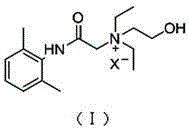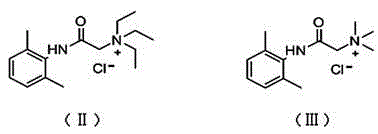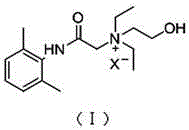Application of N-acetanilide cationic compound in preparation of local nerve blocking drug
A local nerve block and cationic compound technology, which is applied in the direction of active ingredients of heterocyclic compounds, drug combinations, nervous system diseases, etc., can solve the problems of unsatisfactory safety, damage, and safety problems of QX314, and achieve good development prospects Effect
- Summary
- Abstract
- Description
- Claims
- Application Information
AI Technical Summary
Problems solved by technology
Method used
Image
Examples
Embodiment 1
[0016] Compounds I-Br and I-Cl, in which X in the compound of formula (I) are bromine and chlorine, respectively, were used to block the sciatic nerve of rats. Significantly prolonged.
[0017] experimental method
[0018] Select SD rats, half male and half male, and conduct behavioral adaptation one week before the experiment, and select 156 rats that are qualified for the baseline. They were randomly divided into 13 groups, with 12 rats in each group. They received the left sciatic nerve block as shown in Table 1, every 10 min, 30 min, 60 min, 120 min after injection, and then every 2 h to 12 h, and Afterwards, the sensory and motor functions of the limbs were measured by injection every 12 hours until the sensory and motor functions were fully recovered. The time point when the first sensory and motor block takes effect is the onset time of anesthesia; the time point when the first sensory and motor function recovers is the anesthesia failure time; the interval b...
Embodiment 2
[0023] Toxicity test of the above compounds I-Br and I-Cl on rat sciatic nerve.
[0024] experimental method
[0025] All rats in Example 1 were euthanized 7 days after administration. The sciatic nerve at the injection site of each rat was divided into two parts, one of which was stained with HE, and the histological changes of the sciatic nerve were observed under a light microscope; the other was observed under an electron microscope. Light microscope visual scoring standard: 0 points (slightly congested and dilated adventitial vessels, without inflammatory cell infiltration); 1 point (slightly congested and dilated adventitial vessels, with a small amount of inflammatory cell infiltration); 2 points (obvious congested adventitial vessels , expansion, with inflammatory cell infiltration); 3 points (adventitial vessel hyperemia, expansion, spinal cord parenchyma with inflammatory cell infiltration). Electron microscope visual score: 0 points (no obvious pathological chan...
Embodiment 3
[0030] Toxicity experiment of intrathecal administration of I-Br and I-Cl alone.
[0031] experimental method
[0032] As described in Example 1, 80 qualified SD male rats were selected and randomly divided into 8 groups, 10 rats in each group. Under isoflurane anesthesia, 10 ul of the drugs shown in Table 2 were injected intrathecally. Observe whether the rats have irritation symptoms after injection: such as writhing, hissing, convulsions, excitement, coma, or even death, etc. (7) .
[0033] Experimental results
[0034] The results are summarized in Table 3. Intrathecal administration, I-Br and I-Cl did not cause death, and the incidence of irritation symptoms was low; QX314 could cause death, and the incidence of irritation symptoms was high. It shows that the toxicity of I-Br and I-Cl is obviously less than that of QX-314.
[0035]
PUM
 Login to View More
Login to View More Abstract
Description
Claims
Application Information
 Login to View More
Login to View More - R&D
- Intellectual Property
- Life Sciences
- Materials
- Tech Scout
- Unparalleled Data Quality
- Higher Quality Content
- 60% Fewer Hallucinations
Browse by: Latest US Patents, China's latest patents, Technical Efficacy Thesaurus, Application Domain, Technology Topic, Popular Technical Reports.
© 2025 PatSnap. All rights reserved.Legal|Privacy policy|Modern Slavery Act Transparency Statement|Sitemap|About US| Contact US: help@patsnap.com



